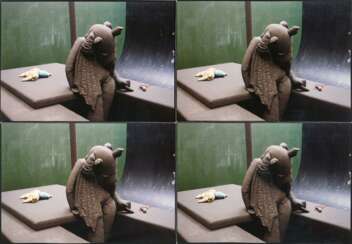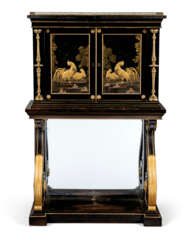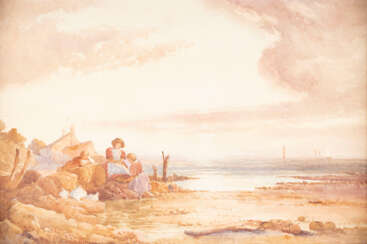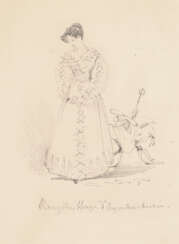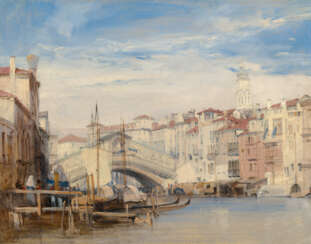boni

Cosima von Bonin is a German contemporary artist. Von Bonin's practice features the use of sculptures, textiles, sound, film and performances. von Bonin draws inspiration from the intellectual, artistic, and musical culture of her neighborhood in Cologne, Germany, where she lives and works.
One focus of von Bonin's artistic works is the relationship between works of art and the world of fashion, music and architecture. She often focuses on collective artistic production frequently including collaboration with other artists as well as parties, DJ sets, music performances and audio and video exhibitions. The exhibitions are of an ephemeral nature intended to reject the classical idea of the individual artistic genius.


Cosima von Bonin is a German contemporary artist. Von Bonin's practice features the use of sculptures, textiles, sound, film and performances. von Bonin draws inspiration from the intellectual, artistic, and musical culture of her neighborhood in Cologne, Germany, where she lives and works.
One focus of von Bonin's artistic works is the relationship between works of art and the world of fashion, music and architecture. She often focuses on collective artistic production frequently including collaboration with other artists as well as parties, DJ sets, music performances and audio and video exhibitions. The exhibitions are of an ephemeral nature intended to reject the classical idea of the individual artistic genius.


Cosima von Bonin is a German contemporary artist. Von Bonin's practice features the use of sculptures, textiles, sound, film and performances. von Bonin draws inspiration from the intellectual, artistic, and musical culture of her neighborhood in Cologne, Germany, where she lives and works.
One focus of von Bonin's artistic works is the relationship between works of art and the world of fashion, music and architecture. She often focuses on collective artistic production frequently including collaboration with other artists as well as parties, DJ sets, music performances and audio and video exhibitions. The exhibitions are of an ephemeral nature intended to reject the classical idea of the individual artistic genius.


Cosima von Bonin is a German contemporary artist. Von Bonin's practice features the use of sculptures, textiles, sound, film and performances. von Bonin draws inspiration from the intellectual, artistic, and musical culture of her neighborhood in Cologne, Germany, where she lives and works.
One focus of von Bonin's artistic works is the relationship between works of art and the world of fashion, music and architecture. She often focuses on collective artistic production frequently including collaboration with other artists as well as parties, DJ sets, music performances and audio and video exhibitions. The exhibitions are of an ephemeral nature intended to reject the classical idea of the individual artistic genius.



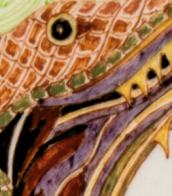





Cosima von Bonin is a German contemporary artist. Von Bonin's practice features the use of sculptures, textiles, sound, film and performances. von Bonin draws inspiration from the intellectual, artistic, and musical culture of her neighborhood in Cologne, Germany, where she lives and works.
One focus of von Bonin's artistic works is the relationship between works of art and the world of fashion, music and architecture. She often focuses on collective artistic production frequently including collaboration with other artists as well as parties, DJ sets, music performances and audio and video exhibitions. The exhibitions are of an ephemeral nature intended to reject the classical idea of the individual artistic genius.


Cosima von Bonin is a German contemporary artist. Von Bonin's practice features the use of sculptures, textiles, sound, film and performances. von Bonin draws inspiration from the intellectual, artistic, and musical culture of her neighborhood in Cologne, Germany, where she lives and works.
One focus of von Bonin's artistic works is the relationship between works of art and the world of fashion, music and architecture. She often focuses on collective artistic production frequently including collaboration with other artists as well as parties, DJ sets, music performances and audio and video exhibitions. The exhibitions are of an ephemeral nature intended to reject the classical idea of the individual artistic genius.


Cosima von Bonin is a German contemporary artist. Von Bonin's practice features the use of sculptures, textiles, sound, film and performances. von Bonin draws inspiration from the intellectual, artistic, and musical culture of her neighborhood in Cologne, Germany, where she lives and works.
One focus of von Bonin's artistic works is the relationship between works of art and the world of fashion, music and architecture. She often focuses on collective artistic production frequently including collaboration with other artists as well as parties, DJ sets, music performances and audio and video exhibitions. The exhibitions are of an ephemeral nature intended to reject the classical idea of the individual artistic genius.


Cosima von Bonin is a German contemporary artist. Von Bonin's practice features the use of sculptures, textiles, sound, film and performances. von Bonin draws inspiration from the intellectual, artistic, and musical culture of her neighborhood in Cologne, Germany, where she lives and works.
One focus of von Bonin's artistic works is the relationship between works of art and the world of fashion, music and architecture. She often focuses on collective artistic production frequently including collaboration with other artists as well as parties, DJ sets, music performances and audio and video exhibitions. The exhibitions are of an ephemeral nature intended to reject the classical idea of the individual artistic genius.


Cosima von Bonin is a German contemporary artist. Von Bonin's practice features the use of sculptures, textiles, sound, film and performances. von Bonin draws inspiration from the intellectual, artistic, and musical culture of her neighborhood in Cologne, Germany, where she lives and works.
One focus of von Bonin's artistic works is the relationship between works of art and the world of fashion, music and architecture. She often focuses on collective artistic production frequently including collaboration with other artists as well as parties, DJ sets, music performances and audio and video exhibitions. The exhibitions are of an ephemeral nature intended to reject the classical idea of the individual artistic genius.
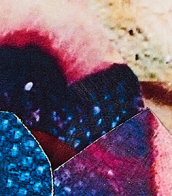

Bonifacio Veronese, a Venetian painter born in 1487 and active until his death in 1553, was a masterful exponent of the High Renaissance style. His work, deeply rooted in the rich art and culture of Venice, exemplified the era's fascination with color, light, and religious themes.
Bonifacio's paintings are celebrated for their vivid portrayal of religious narratives, often infused with a sense of grace and serenity. His use of vibrant colors and ability to create depth and emotion through his characters set him apart from his contemporaries. One of his notable works, the "Virgin and Child with Saints," showcases his skill in composition and his delicate treatment of figures and landscapes.
His contributions to Venetian painting were significant, helping to shape the course of art history during a period teeming with artistic innovation. Bonifacio's works, found in various museums and galleries, offer a glimpse into the artistic fervor that characterized Venice during the Renaissance.
For collectors and connoisseurs, Bonifacio Veronese's art represents a pivotal chapter in the history of painting. His mastery in depicting religious themes with a unique blend of realism and emotion makes his works a valuable addition to any collection.
To stay informed about upcoming sales and auction events featuring Bonifacio Veronese's works, sign up for our updates. This service ensures you receive timely information on new acquisitions and opportunities to add to your collection, focusing exclusively on Bonifacio Veronese's art.

.jpg)
Richard Parkes Bonington was an English Romantic landscape painter, who moved to France at the age of 14 and can also be considered as a French artist, and an intermediary bringing aspects of English style to France. Becoming, after his early death, one of the most influential British artists of his time, the facility of his style was inspired by the old masters, yet was entirely modern in its application. His landscapes were mostly of coastal scenes, with a low horizon and large sky, showing a brilliant handling of light and atmosphere. He also painted small historical cabinet paintings in a freely-handled version of the troubadour style.


Bonifacio Veronese, a Venetian painter born in 1487 and active until his death in 1553, was a masterful exponent of the High Renaissance style. His work, deeply rooted in the rich art and culture of Venice, exemplified the era's fascination with color, light, and religious themes.
Bonifacio's paintings are celebrated for their vivid portrayal of religious narratives, often infused with a sense of grace and serenity. His use of vibrant colors and ability to create depth and emotion through his characters set him apart from his contemporaries. One of his notable works, the "Virgin and Child with Saints," showcases his skill in composition and his delicate treatment of figures and landscapes.
His contributions to Venetian painting were significant, helping to shape the course of art history during a period teeming with artistic innovation. Bonifacio's works, found in various museums and galleries, offer a glimpse into the artistic fervor that characterized Venice during the Renaissance.
For collectors and connoisseurs, Bonifacio Veronese's art represents a pivotal chapter in the history of painting. His mastery in depicting religious themes with a unique blend of realism and emotion makes his works a valuable addition to any collection.
To stay informed about upcoming sales and auction events featuring Bonifacio Veronese's works, sign up for our updates. This service ensures you receive timely information on new acquisitions and opportunities to add to your collection, focusing exclusively on Bonifacio Veronese's art.

.jpg)
Richard Parkes Bonington was an English Romantic landscape painter, who moved to France at the age of 14 and can also be considered as a French artist, and an intermediary bringing aspects of English style to France. Becoming, after his early death, one of the most influential British artists of his time, the facility of his style was inspired by the old masters, yet was entirely modern in its application. His landscapes were mostly of coastal scenes, with a low horizon and large sky, showing a brilliant handling of light and atmosphere. He also painted small historical cabinet paintings in a freely-handled version of the troubadour style.

.jpg)
Richard Parkes Bonington was an English Romantic landscape painter, who moved to France at the age of 14 and can also be considered as a French artist, and an intermediary bringing aspects of English style to France. Becoming, after his early death, one of the most influential British artists of his time, the facility of his style was inspired by the old masters, yet was entirely modern in its application. His landscapes were mostly of coastal scenes, with a low horizon and large sky, showing a brilliant handling of light and atmosphere. He also painted small historical cabinet paintings in a freely-handled version of the troubadour style.

.jpg)
Richard Parkes Bonington was an English Romantic landscape painter, who moved to France at the age of 14 and can also be considered as a French artist, and an intermediary bringing aspects of English style to France. Becoming, after his early death, one of the most influential British artists of his time, the facility of his style was inspired by the old masters, yet was entirely modern in its application. His landscapes were mostly of coastal scenes, with a low horizon and large sky, showing a brilliant handling of light and atmosphere. He also painted small historical cabinet paintings in a freely-handled version of the troubadour style.

.jpg)
Richard Parkes Bonington was an English Romantic landscape painter, who moved to France at the age of 14 and can also be considered as a French artist, and an intermediary bringing aspects of English style to France. Becoming, after his early death, one of the most influential British artists of his time, the facility of his style was inspired by the old masters, yet was entirely modern in its application. His landscapes were mostly of coastal scenes, with a low horizon and large sky, showing a brilliant handling of light and atmosphere. He also painted small historical cabinet paintings in a freely-handled version of the troubadour style.







